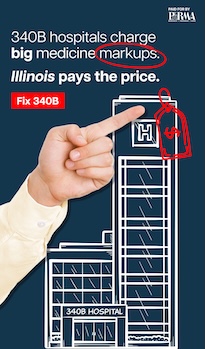* Click here and here for some background. The Illinois State Board of Education on Friday…
The Illinois State Board of Education (ISBE) today released annual allocations for Evidence-Based Funding (EBF) for Fiscal Year 2026, reflecting continued and historic commitment to equitable school funding. Under Governor JB Pritzker, the state has increased EBF by $2.1 billion, bringing the total annual investment to $8.9 billion.
The General Assembly appropriated an additional $307 million for EBF in FY 2026. Of that amount, $5.2 million is specifically earmarked to support new alternative schools that serve students with specialized needs. The remaining $301.8 million is designated for distribution through EBF tiers, with 99% of the new funds going to the state’s highest-need districts. […]
Nine years of investments in EBF have raised the funding floor, accomplishing the main goal of EBF, which is to focus increases in state funding toward districts with the greatest need. The number of fully funded districts, those at or above 90% adequacy, has grown from 194 in FY 2018 to 313 in FY 2026. The formula considers enrollment, student demographics, local funding capacity, and 34 cost factors outlined in statute to ensure funding is responsive and equitable.
Every school district will receive at least the same amount of funding as last year through the Base Minimum Funding, with the additional FY 2026 EBF Tier appropriation of $301.8 million distributed equitably based on district need. This year’s increase in EBF investment reflects a pause in funding for the Property Tax Relief Grant, which is typically allocated $50 million.
While the FY 2026 investment reinforces Illinois’ strong trajectory toward equity, this year’s data reflects a slight dip in the average Percentage of Adequacy across Illinois school districts due to changing economic conditions. A 41.3% drop in Corporate Personal Property Replacement Tax (CPPRT) revenue, combined with rising education costs, resulted in a modest decline in the average funding adequacy for districts below 90%, from 77.1% in FY 2025 to 76.6% in FY 2026. Still, that average remains nearly 10 percentage points higher than in FY 2018, when it was just 67.1%.
* Chalkbeat Chicago…
Chicago Public Schools will receive an additional $76 million from the state this fiscal year for a total of $1.9 billion, according to new data released by the state on Friday.
The new figures indicate Chicago had a significant drop in local tax revenue and an increase in the number of English learners, giving it higher priority for additional state dollars. The new calculations also show that CPS is less adequately funded under the state’s formula than it was last year and will now need about $1.6 billion to reach adequate funding.
* WBEZ’s Sarah Karp…
CPS is one of more than 300 under-funded districts that is getting a smaller percentage of what it needs compared to just a year ago. State law calls for all schools to be funded to at least 90% of adequacy by 2027, but the Center on Tax and Budget Accountability says that at the current rate the state is funding education, it will take until at least 2034 to reach that level.
For CPS, the percent toward adequacy dropped from 79% to 73%. Statewide, the average percent toward adequacy decreased slightly — by about half a percentage point — to 76.6%. The state points to a significant decrease in revenue from a state tax on corporations, as well as “rising education costs,” such as inflation and cost-of-living raises, for the drop in adequacy. […]
Meanwhile, CPS is grappling with a $734 million budget deficit and has not approved a budget for the coming school year. By law, a balanced budget must be presented next week so that required hearings can take place before the budget is approved at the end of August.
In terms of adequacy levels, the state has once again categorized CPS in Tier 1 — among the districts furthest from adequacy — a position the district shed just two years ago. But the upside of being in this category is that it gets more of the state’s pot of money for education. As a result, CPS will get $76 million more this year than it got last year.
* More from Chalkbeat Chicago…
The state’s second largest district serving almost 34,000 students, Elgin’s U-46, dropped from Tier 1 to Tier 2 and will receive less than last year due to a decline in average student enrollment and students from low-income households. The district will receive an additional $4.8 million, almost $14 million less than it received last year in new money.
Rockford School District 205, the state’s third largest district serving about 26,418 students, is expected to receive an additional $19.7 million in state dollars — $9.5 million more than last year. The district has seen an increase in average student enrollment, English learners, and a significant decrease in local property tax revenues.
…Adding… The Chicago Teachers Union last week…
You can’t make this up.
The state that withholds money from our district held a hearing yesterday to find out why the district is in financial trouble.
State representative Curtis Tarver, who represents Chicago students and their families, called a hearing on CPS school finance to reiterate why he and his colleagues have no solutions or any political will to fund CPS and stabilize successful programs like sustainable community schools.
Here are the facts: While our students go without librarians, art teachers, and basic supplies, Illinois’ wealthiest 5 percent are getting handed $8 billion in Trump tax cuts from his recent budget bill. Add in the $10 billion in tax breaks already baked into Gov. Pritzker’s budget for tech corporations and the ultra-rich, and you’re looking at $18 billion in giveaways to those who need it least.
That’s enough to eliminate CPS’s entire $1.2 billion funding gap 15 times over.
Reminder: It is 2025, not 2012, and we are no longer debating already failed arguments on retirement security versus smaller class sizes. Working families deserve both.
* Related…
* WBEZ | CPS must present a plan to close its deficit within 9 days: What are the options?: Since taking over in June, interim Chicago Public Schools CEO and Supt. Macquline King has been laser-focused on coming up with a plan to close the school district’s $734 million budget deficit. King and her team now have less than two weeks to present a budget in time for legally required hearings and a vote at the Aug. 28 Board of Education meeting.
* Chalkbeat Chicago | Chicago Public Schools cuts 480 janitor positions as it ends all private custodial contracts: The move, which comes as the district is working to close a $734 million deficit, sparked an immediate rebuke and demand for reconsideration from the two unions representing school custodians. Starting Sept. 30, CPS will oversee 2,100 full-time custodians and end seven contracts with private custodial companies. The change will mean cutting about 1,250 private custodians and ending a longstanding practice of contracting with private companies to help clean schools.
* ABC Chicago | IL lawmakers want Chicago Public Schools fully funded, don’t feel all funding should come from state: But while many Thursday acknowledged the state legislature will need to step in, there is also a realization that none of this will happen before the 2026 budget is voted on. There was also pushback by the very legislator who’s proposed the millionaires tax. “There’s no votes outside the city of Chicago to just send the city of Chicago money without sending money to the rest of the state,” said state Rep. Curtis Tarver, assistant majority leader and a Democrat representing Chicago.
* Chalkbeat Chicago | Illinois lawmakers offer no quick solutions for CPS during district finances hearing: “I’m hopeful that we can move past the rhetoric, the talking points and unrealistic demands, and get down to business about how we can do better by CPS and its students,” said Illinois Democrat Rep. Ann Williams, who represents neighborhoods on the North Side of Chicago and chairs the House Executive Committee. Illinois has increased funding for K-12 schools across the state by more than $2 billion under a funding formula created eight years ago, of which $1.1 billion has gone to CPS. The state set a goal to “adequately” fund all school districts by 2027, but they’re projected to miss that deadline. According to the state’s formula last year, Chicago schools need almost $1.2 billion to be considered adequately funded.














- DuPage Saint - Tuesday, Aug 5, 25 @ 8:44 am:
How do other states fully fund their schools? I do not think this state can continue to use real estate taxes a the main source of revenue for schools and at same time claim housing needs to be affordable. How do states with low property taxes afford schools? Is it income tax, sales tax what? Why don’t we copy them if it works?
- Chicagonk - Tuesday, Aug 5, 25 @ 9:01 am:
It’s unfortunate that Pritzker just signed a bill that is going to cost the city an additional $60M annually which could be going to schools. The sweetener bill wasn’t an emergency issue and the idea that Tier 2 is somehow illegal is a convenient union talking point. In no scenario would benefits under the Tier 2 scheme be less than under Social Security.
- City Zen - Tuesday, Aug 5, 25 @ 9:01 am:
==$1.6B short of adequacy. percent toward adequacy dropped from 79% to 73%==
How are other school districts managing this inadequacy? Rockford SD205’s percent toward adequacy is 65% and the adequacy funding gap is $150 million. That’s pretty big for a district of that size, but someone they manage.
If you look at the data across the state, you’ll find dozens of school districts with similar or worse funding adequacy rates as CPS. Much smaller school districts that are tens of millions of dollars short of adequacy. Not ideal, but they’re making it work without all the CPS drama. And none of those districts have nowhere near the economic capacity of Chicago.
- Horace - Tuesday, Aug 5, 25 @ 9:09 am:
Austerity seems inevitable. The Republicans just keep too many of the federal tax dollars we send them.
- P. - Tuesday, Aug 5, 25 @ 9:30 am:
Austerity is a choice in Illinois. We have D leadership across the board and no one with the gumption to make the case, raise taxes and live with it. Sorry not sorry you can only do more with less for so long or it starts to look like the CTA, CPS, the Chicago Park District and worse. Too many people in office hold onto every percentage point from their last election like they can take it to the graves with them or use it help launch themselves to the next higher office meanwhile everything goes to pot. CPS needs to max out efficiency then go to voters for a referendum to get their aging infrastructure straight, then Chicago electeds need to do whatever it takes drive support for additional funding with help from “leadership” to achieve some sort of sustainability that will keep and attract families to the City.
- Merica - Tuesday, Aug 5, 25 @ 9:53 am:
CPS budget woes have 2 root causes that have been extensively analyzed by non political reporters: (1) using Covid funds to hire 7,000 additional staff, including a disproportionate number of central office staff, and (2) empty/underutilized schools that need to be shuttered (see Pro Publica analyses) but won’t be shuttered due to political considerations.
- Louis G Atsaves - Tuesday, Aug 5, 25 @ 9:55 am:
Raise taxes and live with it?
CPS has multiple high schools and other lower grade schools that they refuse to close due to continuing drops in the numbers of students attending there. The problem is well documented and has been well reported. Fix it. Close those empty schools, transfer those students, lay off the employees there, turn off the lights and other utilities.
It ain’t all Trump’s fault. Self inflicted wounds through poor management also needs to be treated.
- Woodworth - Tuesday, Aug 5, 25 @ 10:13 am:
2009 CPS Enrollment (the year before CORE took over the CTU): 440,000+
Likely 2025 Enrollment (after 16 years of CORE): 310,000 or so
Correlation =/= causation, sure. But it does make one wonder. The schools became a political football to an exponential degree during that time.
- JS Mill - Tuesday, Aug 5, 25 @ 10:14 am:
I wrote about this yesterday with regard to Brandon Johnson’s crying about money.
CPS is the only district in the state with the local capacity to raise whatever amount of money for their schools they desire. But people will be mad about taxes. Tough luck buttercup.
Close your empty schools, enact tighter fiscal controls, do a better job with bargaining with CTU (I kid, we know Johnson is there to do their bidding). Antoen hired with ESSER money should be let go, I mean who adds thousands of permanent employees with one time funds? I have had to do all of those things. It is hard. It comes with the territory.
=strong trajectory toward equity=
That is only for urban kids. My kids out here in rural Illinois don’t count. We are getting cut again in transportation, which none of the leaders care about and our elections are too busy worrying about trans athletes, all three of them. Our Tier money is less than $1000. Our base funding minimum has not changed but, well, inflation means we have lost about 25% of the value. At the same time the state has mandated minimum salaries.
Yeah, I feel super bad for CPS.
- NotRich - Tuesday, Aug 5, 25 @ 10:17 am:
MERICA =‘s on point!! CTU forces high schools built for 600 students to stay open with 103 kids. That would never happen in any other Illinois school district. This is all the controlling party in Illinois fault.
- Excessively Rabid - Tuesday, Aug 5, 25 @ 10:21 am:
@Dupage Saint - they start by having a far smaller number of state and local government entities soaking up revenues. Illinois has by far the highest number of any state, yet you would think it would be the end of the world if we consolidated them. Some states have high sales taxes, some have more income taxes, some just scrimp on services and roads. Illinois missed our chance to rationalize our tax system when the graduated income tax didn’t pass. That reflected badly on JB and still does. We also have counterproductive taxes like the death tax, that influences corporate executives to move headquarters out of state.
- Steve - Tuesday, Aug 5, 25 @ 10:52 am:
I wonder how the millionaires tax would be inacted without a change in the Illinois state constitution? If it could be done without a change in the constitution wouldn’t it have already happened??
- JS Mill - Tuesday, Aug 5, 25 @ 11:14 am:
=Correlation =/= causation, sure. But it does make one wonder. The schools became a political football to an exponential degree during that time.=
As much as I would love to hang that on CTU it is almost certainly not their fault. While not true for all schools, declining enrollment is something that does happen. I am certain CTU is not part of the solution though.
- City Zen - Tuesday, Aug 5, 25 @ 11:14 am:
==the state has once again categorized CPS in Tier 1==
There is something inherently wrong with a funding formula that ranks a school district in a city with some of the wealthiest people in the state and a hefty commercial base in its lowest tier.
CPS is the only school district in the state where its enrollment is not a proper reflection of the overall population of the city. Yet someone were expected to fund it like it’s a town completely populated by poor people.
- low level - Tuesday, Aug 5, 25 @ 11:15 am:
==I wonder how the millionaires tax would be inacted without a change in the Illinois state constitution? If it could be done without a change in the constitution wouldn’t it have already happened??==
As far as I know you are absolutely correct. Need a constitutional amendment for a millionaires tax and this failed in 2020. Is there any reason a referendum would be successful today?
- Steve M - Tuesday, Aug 5, 25 @ 11:20 am:
One of the flaws of EBF is that funding always starts with last year and goes up from there. CPS enrollment is down more than 15% from the first year of EBF, yet funding has grown 20%. Make some efforts at right-sizing your spending and have the guts to increase taxes annually like every other district in the state does and then come crying for more
- Friendly Bob Adams - Tuesday, Aug 5, 25 @ 11:30 am:
Totally not a supporter of CTU but they are not to blame for the lower enrollment.
- JS Mill - Tuesday, Aug 5, 25 @ 11:40 am:
=turn off the lights and other utilities.=
You can’t actually do that. If you want to mothball them you have to keep utilities (for heating and cooling. and lights for security) on. The other answer is to bite the bullet and pay for demo. But they need to close schools. We closed a school. Not fund, but it is the fiscally responsible thing.
=One of the flaws of EBF is that funding always starts with last year and goes up from there.=
That is not completely accurate. Your base funding minimum never goes down, but the amount does not always go up. That is especially true if you change tiers. And, as City Zen mentioned, their is no way that CPS should be anything but Tier 4 other than politics.
- Under a rock - Tuesday, Aug 5, 25 @ 11:42 am:
@chicognack === In no scenario would benefits under the Tier 2 scheme be less than under Social Security.===
You’re just making things up. We’re already approaching that scenario in some districts.
https://www.thedailyline.com/illinois-retirement-systems-could-face-safe-harbor-violations-soon-presenting-concern-schools-agencies
https://civicfed.org/sites/default/files/2023-11/Tier2ExplainerCopy.pdf
- anon2 - Tuesday, Aug 5, 25 @ 11:47 am:
== Is there any reason a referendum would be successful today? ==
Ken Griffin no longer lives in the Land of Lincoln, so he likely won’t spend $54 million to defeat it next time.
- Rudy’s teeth - Tuesday, Aug 5, 25 @ 11:53 am:
Close under enrolled schools and convert buildings into housing. If LaSalle Street office towers are being converted to housing and condos, the under enrolled schools could serve as a resource rather than an albatross in the community.
- Pundent - Tuesday, Aug 5, 25 @ 12:04 pm:
=Ken Griffin no longer lives in the Land of Lincoln, so he likely won’t spend $54 million to defeat it next time.=
I don’t think you’d need $54M to defeat a referendum cast as a “CPS bailout.”
If anything the actions of Johnson/CTU make it less likely that we’ll see any movement on a progressive tax anytime soon.
- Adroit Opiner - Tuesday, Aug 5, 25 @ 12:14 pm:
In FY18 CPS began receiving over $1.1B more in annual revenues (~60% from EBF and Normal Cost contributions, and 40% from reinstated/increased pension levy) on a $5.9B operating budget. That’s a 20% increase in operating revenue overnight and in perpetuity. Meanwhile, since EBF passed to today, CPS’s annual operating budget has grown by 57%; from $5.9B to $9.3B. I will always posit education needs to be heavily invested in, but man, I’m sure a lot of other vital services would love to have seen the same influx in funding from the state. All while CTU berates the Governor for not doing more and at a time when Illinois’ federal funds are in massive jeopardy and there are numerous other fiscal fires blazing. That’s one fortified bubble they’re living in.
- Juice - Tuesday, Aug 5, 25 @ 12:35 pm:
No doubt that CPS needs to get its act together on spending, not only examining the additional operations that were added with the use of COVID money as well as rightsizing the district to its current population.
The Board also needs to have an honest conversation about its tax rate. The current rate is 3.8%. The average rate in the state for a unit district is 4.5%. If CPS taxed at that rate, it would be about an additional $700 million of locally raised revenue.
But on top of that, the State also ought to look at how it is sending money out the door. There are about 240 districts that are above 100% of adequacy, but because of the base funding minimum, the state sends at a minimum what those district received the prior year to the tune of over $280 million. There should at least be a conversation of whether the state should continue the investments in those districts at the level they are currently receiving funds as opposed to using those dollars to bring Tier 1 and Tier 2 districts up further.
- City Zen - Tuesday, Aug 5, 25 @ 12:36 pm:
==Your base funding minimum never goes down, but the amount does not always go up==
But the hold harmless provision means the base minimum funding from the prior year is tacked onto the current year, along with new money. The base funding minimum therefore keeps increasing year after year, regardless of enrollment declines.
It’s fair to ask if EBF were recalibrated based on CPS enrollment today versus 2018, would CPS’s total base funding minimum still be as large?
I think part of the issue is we’re holding CPS to a funding standard that is partially based on outdated enrollment numbers still embedded in the formula.
- Formerly Unemployed - Tuesday, Aug 5, 25 @ 1:00 pm:
The birthrate is dropping. Not only will we see less immigration, but Trump is kicking many current immigrants out. The loss of students in CPS isn’t CTU’s fault, but it is a real problem, and maybe CPS needs to have fewer buildings, teachers, and administrators.
The Archdiocese has been closing and merging schools for years, because the demographics call for it.
- illinifan - Tuesday, Aug 5, 25 @ 1:11 pm:
DuPage Saint, I took a look at a couple of factors comparing to Arizona (which has a pretty low property tax). Median salary for a high school teacher is similar to Illinois. One variant is pension. AZ teachers contribute 12% and the school districts match. Illinois it is 9% from the teacher (and often the school district picks up this cost and in some cases there is an additional 1.4% to cover health care in retirement) and the state does the match instead of the district. Illinois gets a lower federal match for the schools than many other states (particularly southern states which receive more from the feds than they contribute).
- Steve - Tuesday, Aug 5, 25 @ 1:31 pm:
-I don’t think you’d need $54M to defeat a referendum cast as a “CPS bailout.”-
Most states that have state income taxes have a progressive income tax code. It generally is a feature of Blue states.
- Juvenal - Tuesday, Aug 5, 25 @ 1:32 pm:
=== How are other school districts managing this inadequacy? Rockford SD205’s percent toward adequacy is 65% and the adequacy funding gap is $150 million….but someone they manage. ===
Rockford is not “managing” or “making it work.”
Rockford has lower standardized test scores for Language and for Math than CPS, and a lower graduation rate.
Once you look at the data, you realize that CPS is actually doing extremely well despite how chronically underfunded they are and given the challenges facing the kids they serve.
They work small miracles every day, but they cannot turn water into wine, or feed 10K with two fishes and five loaves of bread.
This is not a Chicago/CPS problem. CTU might be one of the loudest at ringing the alarm, but this is a statewide problem and Rockford and the other districts are surely watching and rooting for a bigger pie that allows them to get a bigger piece.
- Rich Miller - Tuesday, Aug 5, 25 @ 1:36 pm:
=== It generally is a feature of Blue states. ===
Try googling before commenting.
https://taxfoundation.org/data/all/state/state-income-tax-rates/
- Juice - Tuesday, Aug 5, 25 @ 1:40 pm:
City Zen, the formula is taking into account current enrollment (or at least prior year).
So the new dollars that CPS receives is taking into account their declining enrollment and is beyond the statutory hold harmless for the base funding minimum.
- City Zen - Tuesday, Aug 5, 25 @ 2:07 pm:
==Most states that have state income taxes have a progressive income tax code.==
And those states tax retirement income. All but one have much lower property taxes. Another one has no sales tax at all. While the permutations are many, almost all have overall lower tax burdens than us, so it’s simply not just about a graduated rate.
The Fair Tax failed in the most opportune climate for it to pass. Let it go.
- Steve - Tuesday, Aug 5, 25 @ 2:30 pm:
-” 27 states and the District of Columbia levy graduated-rate income taxes” -
Rich, thank you.
- Three Dimensional Checkers - Tuesday, Aug 5, 25 @ 3:39 pm:
It’s either raid the TIF funds like Pedro wanted or MBJ/CTU/Harden’s Thelma and Louise debt strategy. I don’t see how the other options Karp lists in her article are feasible.
- Woodworth - Tuesday, Aug 5, 25 @ 4:45 pm:
@JS Mill:
==CPS is the only district in the state with the local capacity to raise whatever amount of money for their schools they desire.==
Not quite. Their levy is capped.
- Rich Miller - Tuesday, Aug 5, 25 @ 5:14 pm:
===Their levy is capped===
Ever heard of a referendum? That’s how all other districts do it.
- JS Mill - Tuesday, Aug 5, 25 @ 6:49 pm:
=Their levy is capped.=
Something called a TIF would like a word. And what Rich said.
To the update…CTU reminding everyone why they should be ignored. CPS is not the only one “owed” money. Regular and Special Education transportation hasn’t been fully funded since Pat Quinn was governor. Then there was 2012-2018. They never paid any of us back the money we are owed. But CPS got theirs.